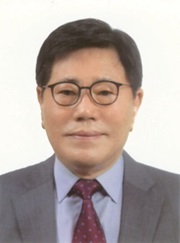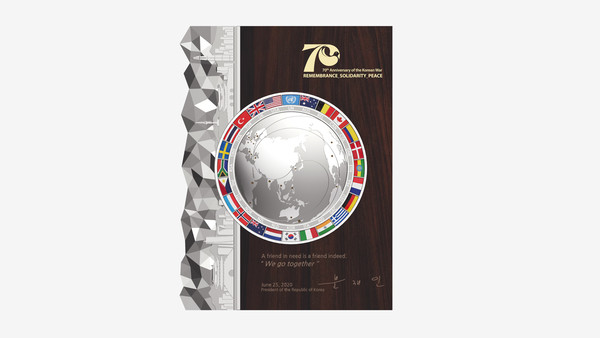At the Deoksu Palace in Seoul on July 7
By Chief Editorial Writer Song Na-ra with Reporter Jang Gun-ju
Minister Park Sam-duck of Patriots and Veterans Affairs hosted a presentation ceremony of “Plaque of Peace” plaque at the Seokjo-jeon Building at the Deoksu-gung Palace in Seoul on July 7, 2020 to express Korea’s gratitude to the service and sacrifice of the United Nations Forces veterans who fought and participated in the Korean War (1950-3).

The day coincides with July 7, 1950 when the U.N. resolution was passed to create the United Nations Command. The Deoksu-gung Palace was the base of the Korean Empire’s diplomacy at the time.
The ceremony was aimed at strengthening the ties and friendship between Korea and the U.N. Forces who fought in Korea to help Korea defend herself from the North Korean and Chinese Communist Invasion Forces during the Korean War.

The Deoksu-gung Palace in the erstwhile days was used by King Gojong of the Joseon Dynasty of Korea.
This was followed by presentation of the pledge of allegiance, presentation of Plaque of Peace and performances. A traditional Korean Honor Guard group paid the utmost respects to the ceremony.
The ceremony was held in compliance with the rules and guidelines aimed at protecting the participants from the on-going COVID-19 disease.

At the ceremony, Prime Minister Chung Sye-kyun presented a Plaque of Appreciation to each of the ambassadors present at the meeting, whose country sent troops to Korea for the defense of freedom and democracy of Korea.
The plaques were in commemoration of the 70th anniversary of the Korean War and were intended to serve as a reminder of special bonds forged in blood between Korea and the 22 United Nations member countries who sent troops to Korea to help the Republic of Korea defend her freedom and democracy from the North Korean and Chinese invasion forces.
The Plaque of Peace was made by smelting the items used by the U.N. Forces personnel during the Korean War together with the barbed wire from the Arrowhead Hill in the demilitarized zone (DMZ). The plaque symbolizes “Peace Made Together” with Korean and the U.N. member countries sending troops for Korea.
On July 7, 1950, the United Nations Security Council adopted Resolution 84 to create the United Nations Command to protect peace and safety of the Republic of Korea. In this sense, the day marked an important turning point in the Korean War providing for the participation of the United Nations Forces in the Korean War.
On this occasion, the Korean Ministry of Patriots and Veterans Affairs issued the following statement: “The MPVA will continue cooperation and friendship with the U.N. troop-sending member countries in order to maintain the valuable and special bonds forged in the battlefields 70 years ago.”
The Deoksu-gung Palace was the residence of King Gojong of the Joseon Dynasty, the last king of the Dynasty and the first Emperor of Korea to conduct diplomacy. Jeong-dong, where the palace is located, has a number of foreign diplomatic missions today.
During the Korean War, the palace was targeted for bombing by the U.S. Air Force while it was occupied by the North Korean Forces. However, the palace was spared from bombing thanks to First Lieutenant James Hamilton.
A brief account of the Korean War:
The predawn quiet of a rainy, peaceful Sunday morning, June 25, 1950, was abruptly shattered by the crash of cannons and the snarl of automatic weapons as soldiers of North Korea marched southward. The invading forces breached the 38th parallel and rolled back the lightly-armed Republic of Korea Army constabulary forces toward their capital of Seoul.
Two days later, the United Nations called on the countries of the world to unite and assist in driving the invader from the ROK. In its resolution, the UN Security Council named the United States as executive agent to implement the resolution and direct UN military operations in Korea.
President Harry S. Truman, armed with the UN resolution and recognizing a threat to the free world, determined the U.S. could no longer remain neutral while communist powers trampled the free nations of the world. General of the Army.
Douglas MacArthur, Commander-in-Chief, Far East Command, was ordered to provide whatever assistance was needed to repel this invasion. General MacArthur committed U.S. air and naval forces and on July 24, in Tokyo, established General Headquarters, United Nations Command.
By then, the U.N. had issued a further appeal to all member nations to provide what military and other aid they could to assist the ROK Government in repelling the invaders. The first ground troops to enter battle on the side of the ROK were advance elements of the U.S. 21st Infantry Regiment, 24th Infantry Division. Units were airlifted from occupation duties in Japan to form "Task Force Smith." The unit was committed on July 5th a few miles north of Osan.
In the face of overpowering enemy strength, the UNC fought delaying actions as ROK and U.S. units withdrew down the peninsula. Outnumbered and out-gunned, they traded space for time as they waited for the pledged assistance from other countries of the UN.
On August 29, 1950, the British Commonwealth's 27th Brigade arrived at Busan to join the UNC, which until then included only ROK and U.S. forces. The 27th Brigade moved into the Naktong River line west of Taegu.
Troop units from other countries of the UN followed in rapid succession; Australia, Belgium, Canada, Colombia, Ethiopia, France, Greece, Luxembourg, the Netherlands, New Zealand, the Philippines, Thailand and Turkey. The Union of South Africa provided air units which fought alongside the air forces of other member nations. Denmark, India, Norway, and Sweden provided medical units. Italy provided a hospital, even though it was not a UN member.
During the three years of the Korean War, military forces of these nations fought and died together as members of the UNC. They fought for the freedom of the Korean people and to demonstrate UN resolve to stop unprovoked aggression.
Through the freezing winters and the sweltering heat of the Korean summers, men from Britain, Ethiopia, the Republic of Korea, Thailand, Turkey, United States, and other contributing countries demonstrated individual and collective heroism in facing human waves of north Korean and Chinese aggressors. Few battles in the history of modern warfare have wrought the heartbreak and the frustration of this struggle.
Bloody Ridge, Chosin Reservoir, Hamhung, Heartbreak Ridge, Hwachan Reservoir, Iron Triangle, Punch Bowl and Pusan Perimeter -- all were mileposts in the seesaw battle for Korea's freedom. The dust of Old Baldy was crimsoned with blood of valiant members of the UNC; the Han and Imjin Rivers ran red with blood of UN fighting men.
On July 27,1953, the shooting ended. An armistice was signed at Panmunjom which provided for the end of the fighting and eventual political settlement of the war. The shooting ended, but the troops remained, each side pulling back 2,000 meters from the last line of military contact to insure peace, to watch the Demilitarized Zone, and to guard against any resumption of hostilities.
In a green field at Tanggok, located near the port of Busan, stand myriad reminders of the Korean War. Simple white crosses, standing near the sign of the "Crescent and the Star" and the "Star of David" are bleak, symbolic representatives of the 33,629 Americans, numberless Koreans, 717 Turkish soldiers, and 1,109 soldiers of the United Kingdom who gave their lives during the struggle. Also sharing this place of honor are the symbols for the dead of the 12 other nations whose fighting men died to keep Korea free.
With the coming of the armistice, UNC members turned their attention to the tremendous task of assisting in rebuilding a war-torn economy. Assisting the people of the ROK in restoring and reconstructing a nation almost completely devastated by a war that leveled cities and destroyed farmlands was a gigantic project that was years in the accomplishment
The Korean War remembrance items sent by the participating countries:
U.S. (water bottle) ② UK (veteran badge) ③ Canada (bayonet) ④ Turkey (combat medal) ⑤ Australia (combat medal) ⑥Philippines (veteran badge) ⑦ Thailand (canteen) ⑧ Netherlands (combat medal) ⑨ Colombia (combat medal) ⑩ Greece (empty shell) ⑪ New Zealand (combat medal) ⑫ Ethiopia (veteran badge) ⑬ Belgium(iron helmet) ⑭ France (combat battalion badge) ⑮ South Africa (veteran badge) Luxemburg (iron helmet) ⑰ India (handle) ⑱ Norway (combat medal) ⑲ Demark (Jutlandia nurse medal) ⑳ Sweden (combat nurse button, brassware) ㉑ Italy (medical saw) ㉒ Germany (Red Cross coin) ㉓ Republic of Korea (DMZ barbed wire).

